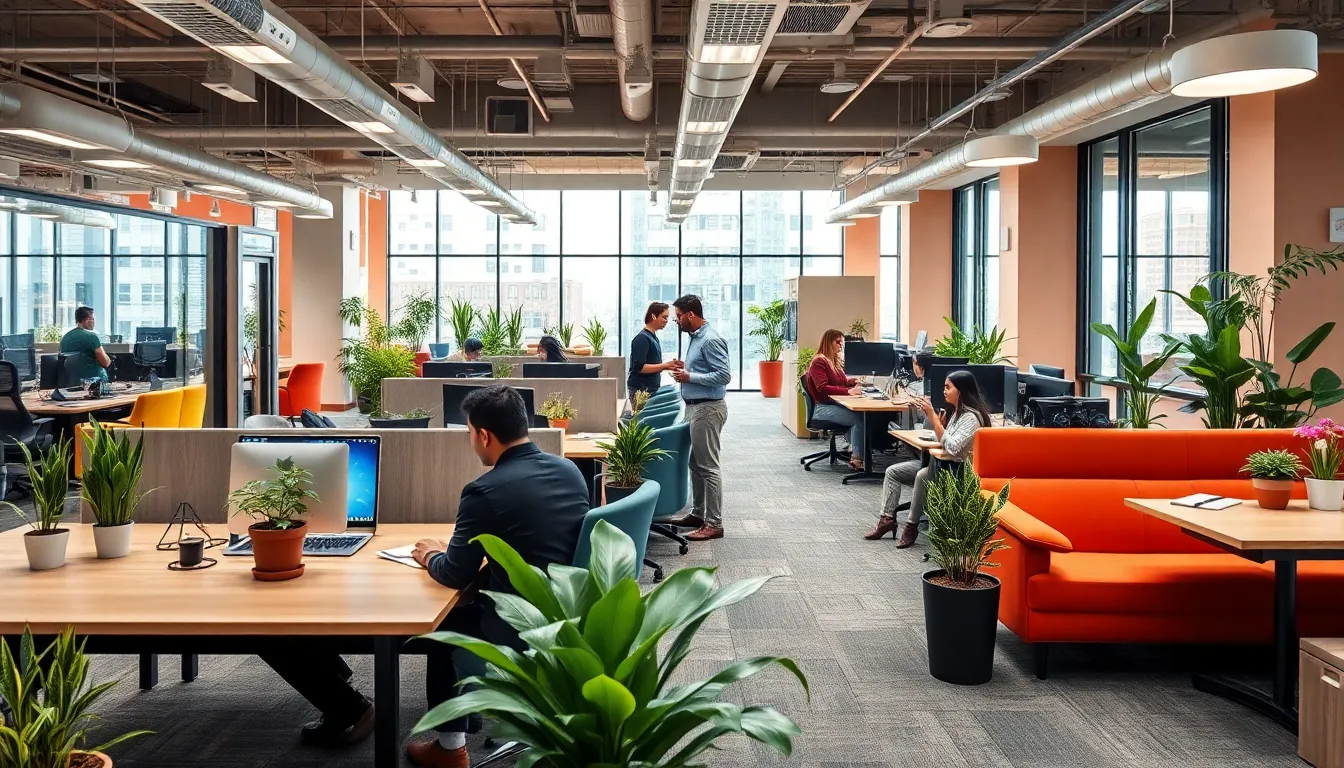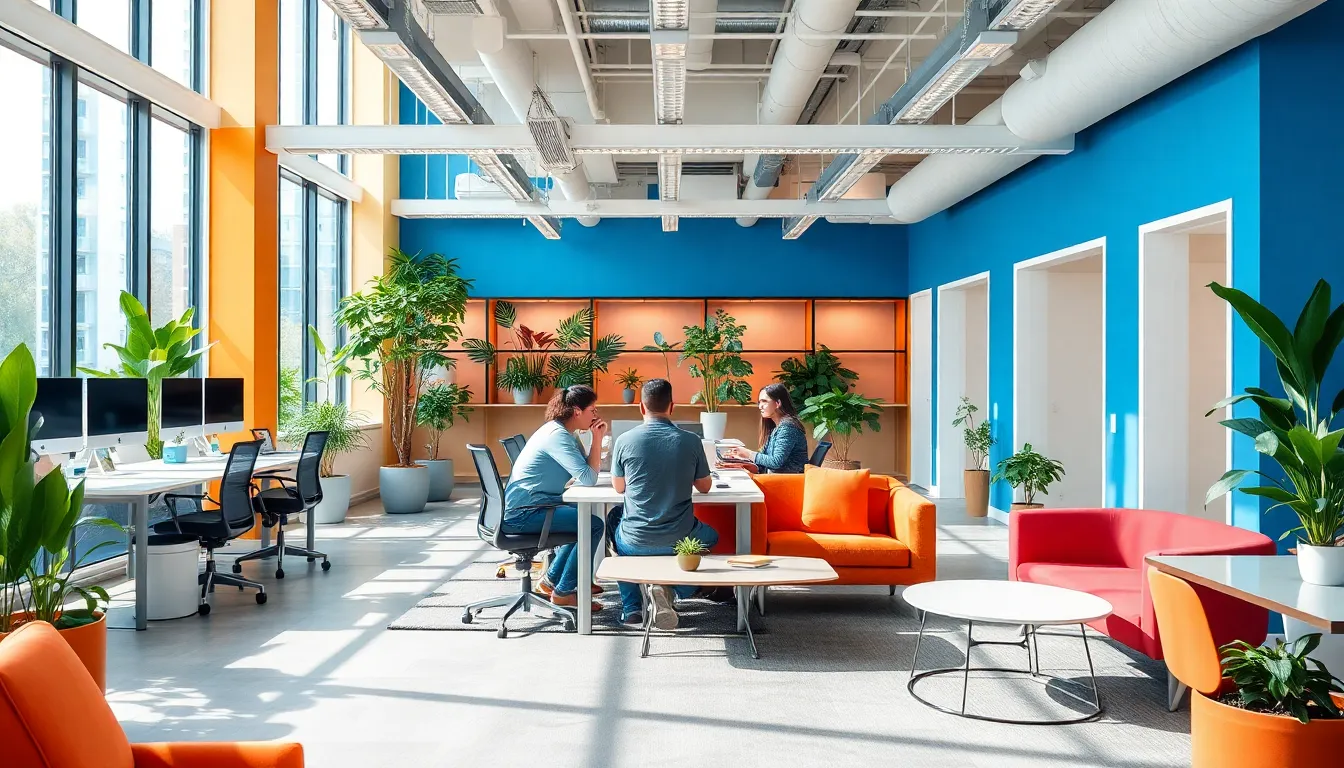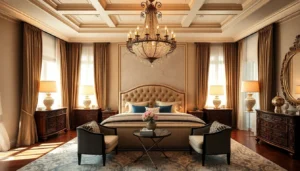Table of Contents
ToggleIn the world of commercial office interiors, first impressions matter more than a perfectly brewed cup of coffee on a Monday morning. A well-designed workspace not only boosts productivity but also transforms a mundane office into a vibrant hub of creativity. Imagine walking into an office that feels less like a stuffy cubicle farm and more like a sleek, modern oasis where ideas flow as freely as the office snacks.
Gone are the days of bland beige walls and uninspiring furniture. Today’s office interiors are all about striking a balance between functionality and flair. From open layouts that encourage collaboration to cozy nooks perfect for brainstorming sessions, the right design can make employees feel energized and motivated. So, let’s dive into the exciting world of commercial office interiors and discover how a little creativity can turn any workspace into a thriving environment.
Overview of Commercial Office Interiors
Commercial office interiors play a vital role in shaping workplace culture and employee performance. Design choices impact both aesthetic appeal and functionality, influencing how employees interact and collaborate. Modern offices prioritize open layouts and flexible spaces, fostering an environment that encourages teamwork and creative thinking.
Natural light and biophilic design elements enhance the atmosphere, improving well-being and productivity. Incorporating greenery contributes to a healthier workspace, positively affecting mood and energy levels. Comfortable seating and varied work areas provide employees with options, allowing them to choose settings that suit their tasks best.
Color palettes hold significance as well. Bright hues stimulate creativity, while neutral tones promote focus. By strategically combining colors, designers create an inviting and stimulating environment that motivates employees. Layout configurations also matter; collaborative zones encourage group work, while quiet areas support concentration and individual tasks.
Technology integration is essential in today’s commercial office environments. Smart solutions streamline workflows and enhance connectivity, enabling teams to collaborate more effectively. Incorporating ergonomic furniture reduces strain and improves comfort, further supporting employee well-being.
Well-thought-out commercial office interiors significantly impact employee satisfaction, engagement, and productivity. Prioritizing effective design elements, incorporating technology, and addressing comfort create inspiring workplaces. By focusing on these aspects, businesses can transform their offices into dynamic hubs that foster success.
Key Elements of Commercial Office Interiors

Commercial office interiors hinge on several key elements that shape functionality and aesthetics. Effective design incorporates layout, furniture, and color schemes to create an inspiring environment.
Layout and Space Utilization
Space utilization defines how well an office accommodates its employees. Open layouts promote collaboration while maintaining individual workspaces for focus. Dedicated zones for meetings, brainstorming, and relaxation cater to various work styles. Flexibility in layouts allows for adjustments based on team needs. Smart use of dividers can create private spaces without sacrificing openness. Zones for quiet concentration or social interaction enhance employee satisfaction and productivity.
Furniture Selection
Selecting appropriate furniture enhances comfort and supports various tasks. Ergonomic chairs and desks promote proper posture and reduce fatigue. Versatile furniture options, like movable tables and collaborative seating, adapt to changing needs. Quality materials ensure durability and long-term use. Integrating furniture that aligns with the company’s brand image increases cohesiveness. Thoughtful choices in furniture also impact aesthetic appeal and create inviting workspaces.
Color Schemes and Aesthetics
Color schemes contribute significantly to the office atmosphere. Bright colors energize and inspire creativity in collaborative areas. Neutral tones establish focus in workspaces, allowing employees to concentrate. A strategic mix of colors creates visual interest while maintaining harmony. Specific hues can influence mood and productivity, making their selection crucial. Patterns and textures, when used thoughtfully, enhance the overall aesthetic appeal. Balancing these elements fosters a welcoming and engaging environment.
Trends in Commercial Office Interiors
Current trends in commercial office interiors emphasize innovation and adaptability. Companies increasingly focus on creating spaces that enhance employee well-being and foster collaboration.
Biophilic Design
Biophilic design incorporates natural elements within office spaces. Plants, natural light, and landscapes create a connection to nature that significantly improves employee mood and productivity. Research indicates that access to greenery leads to reduced stress levels and increased creativity. Integrating features like living walls, indoor gardens, and water elements captures attention while promoting a calming atmosphere. Natural materials such as wood and stone add warmth, fostering a sense of comfort. Effective use of biophilic design transforms any workspace into a rejuvenating environment.
Flexible Workspaces
Flexible workspaces adapt to diverse work styles and changing team dynamics. Companies design areas that encourage collaboration, focus, and relaxation, meeting various employee needs. Configurable layouts allow teams to reconfigure spaces based on specific tasks or projects, maximizing efficiency. A mix of communal areas, private pods, and meeting rooms ensures that employees can choose the environment suitable for their work. Recent studies show that employees working in flexible environments report higher job satisfaction. Implementing these adaptable designs reflects a commitment to both productivity and employee engagement.
Benefits of Well-Designed Commercial Office Interiors
Well-designed commercial office interiors enhance employee productivity and satisfaction. Aesthetic appeal and functionality work together to create a motivating atmosphere. Natural light, for instance, improves mood and reduces stress levels, leading to better performance.
Employee interactions increase in open layouts that foster collaboration. Diverse workspaces, including cozy brainstorming areas, cater to various preferences and tasks. High-quality, ergonomic furniture supports comfort, contributing positively to productivity.
Color schemes also play a significant role in influencing workplace dynamics. Bright colors stimulate creativity, while neutral tones promote focus. Mixing colors and patterns creates an inviting environment that engages employees.
Integration of technology streamlines workflows in modern office spaces. Smart solutions improve connectivity, making it easier for teams to share ideas. Dedicated zones for meetings and quiet work ensure that all team styles and needs receive attention.
Flexible layouts adapt to changing team dynamics and collaboration needs. Research indicates that employees in flexible environments report higher job satisfaction and overall engagement. This adaptability not only maximizes efficiency but also cultivates a culture of innovation.
Incorporating biophilic design features, like plants and living walls, further enhances employee well-being. Such elements create a soothing atmosphere, contributing to a positive organizational culture. Overall, prioritizing thoughtful design elements leads to a dynamic office environment that supports employee success.
Challenges in Designing Commercial Office Interiors
Designing commercial office interiors involves numerous challenges. Space constraints limit design possibilities, making it essential to balance aesthetics and functionality. Architects and designers often face restrictions regarding layout configurations, creating tension between open spaces and private areas.
Budget constraints present another challenge. Companies often must prioritize cost-effective solutions while still achieving a modern look. Choosing high-quality materials and versatile furniture can strain finances, especially for startups or smaller businesses.
Employee needs also influence design decisions. While collaborative environments promote teamwork, individual work styles require dedicated quiet zones. Striking the right balance between these elements is critical for maximizing productivity and comfort.
Technology integration poses additional hurdles. With rapid advancements, ensuring that office spaces accommodate smart technologies becomes imperative. Designers must account for wiring, audio-visual equipment, and other tech installations without detracting from the office’s visual appeal.
Sustainability concerns arise frequently. Modern businesses face increasing pressure to adopt eco-friendly practices in their office designs. Selecting sustainable materials and incorporating energy-efficient systems is vital but can complicate decisions when balancing design and practicality.
Lastly, color selection impacts employee mood and productivity. Bright colors may energize collaborative spaces, while neutral tones help enhance focus. It’s crucial to select the right palette that reflects the company’s brand while also addressing employee preferences.
Addressing these challenges requires thoughtful planning and innovation. Successful designs go beyond aesthetics; they create environments that support productivity and collaboration, ultimately contributing to a positive workplace culture.
The evolution of commercial office interiors is pivotal in shaping workplace dynamics. Embracing modern design principles not only enhances aesthetic appeal but also boosts employee engagement and productivity. By prioritizing flexible layouts and incorporating elements like natural light and biophilic design, companies can create environments that inspire creativity and collaboration.
Addressing challenges such as budget constraints and diverse work styles remains essential. Thoughtful planning and innovative solutions can lead to spaces that balance functionality with visual appeal. Ultimately, investing in well-designed office interiors reflects a commitment to fostering a positive organizational culture that values employee well-being and success.




